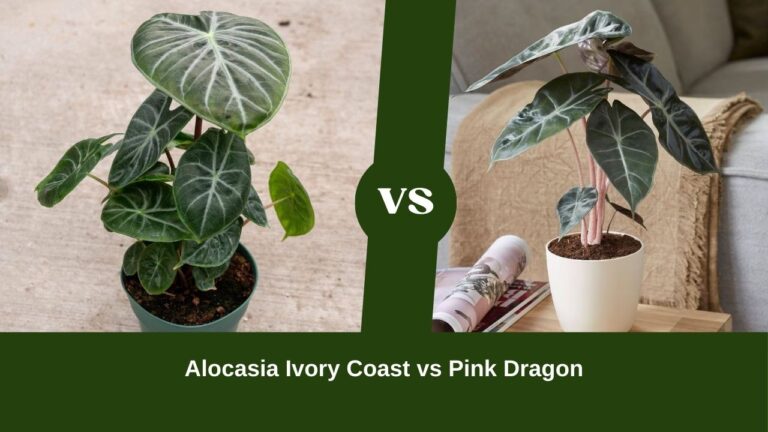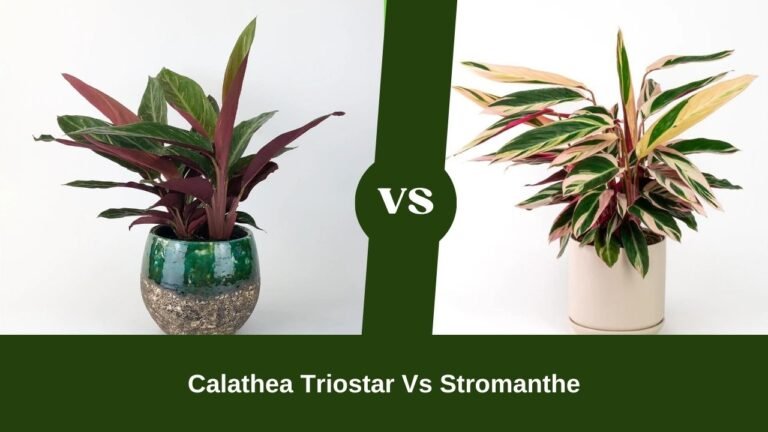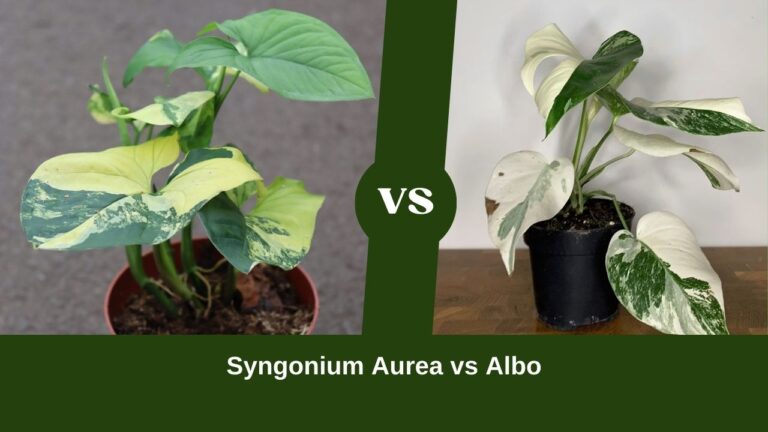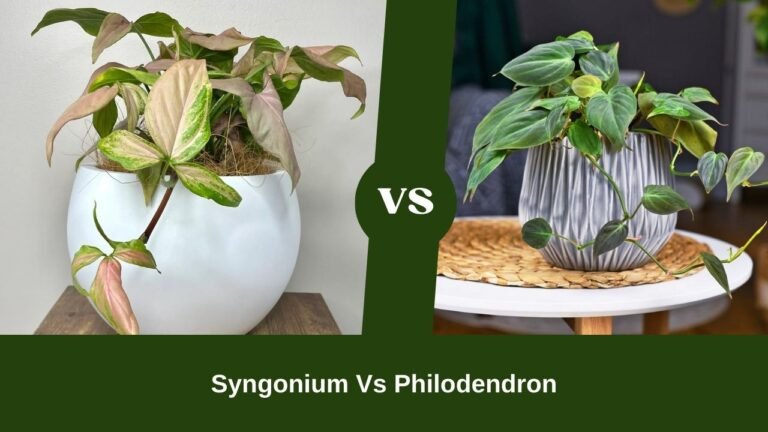A Clear Picture Of Caladium Vs Calathea Debate [Including 5 Best Plants Recommendations!]
![A Clear Picture Of Caladium Vs Calathea Debate [Including 5 Best Plants Recommendations!]](https://plantparadiso.com/wp-content/uploads/2024/02/Calathea-Debate-vs-Caladium.jpg)
Sprucing up your garden or indoor haven with a pop of lively greenery? Well, you’ve got two cool options in the ring: Caladium and Calathea. These plants bring some adorable leaf game, instantly kicking up the vibes in any space.
So, what are the main differences between these plants? The main differences between Caladium and Calathea lie in their leaf shapes and patterns, light, and moisture requirements. Sometimes, growth habits and temperature tolerances can vary depending on the condition they’ve been raising.
There are lot of things you should know if you’re having a dilemma about which plant to choose. I suggest you to read this entire article, you won’t be disappointed I reckon.
![A Clear Picture Of Caladium Vs Calathea Debate [Including 5 Best Plants Recommendations!]](https://plantparadiso.com/wp-content/uploads/2024/02/Calathea-Debate-vs-Caladium-1024x576.jpg)
Table of Contents
The Tropical Origins of Caladium and Calathea
Beyond their stunning leaves, both Caladium and Calathea share a heritage deeply rooted in the tropical regions of South and Central America.
Caladiums
Trace their origin to the Amazon Basin in Brazil. They thrive naturally in the shaded, humid understories of the rainforests, with dappled sunlight filtering down through the canopy. The diversity of Caladium species and cultivars we enjoy today arose from hybridization work conducted in the early 19th century.
Calatheas
Also hail from the tropical Americas, with their ancestral home in the Atlantic Forests of Brazil. They are accustomed to warm temperatures and high rainfall. Like Caladiums, they flourish on the shaded jungle floor with shelter from direct sun and plentiful moisture.
The hot and humid conditions of these South American tropical ecosystems shaped the growing requirements of both plants. They need indoor environments that mimic the partially shaded, warm, and moist rainforest habitats where they evolved.
Both Caladium and Calathea also hold significance in the cultural traditions of indigenous South American peoples. Ethnobotanical records show a history of use as food, medicine, ceremony, body decoration, and craft materials by tribes across the regions where these plants originated.
What Makes These Two Plants Unique?
First, let’s take a look why both of these plants are unique.
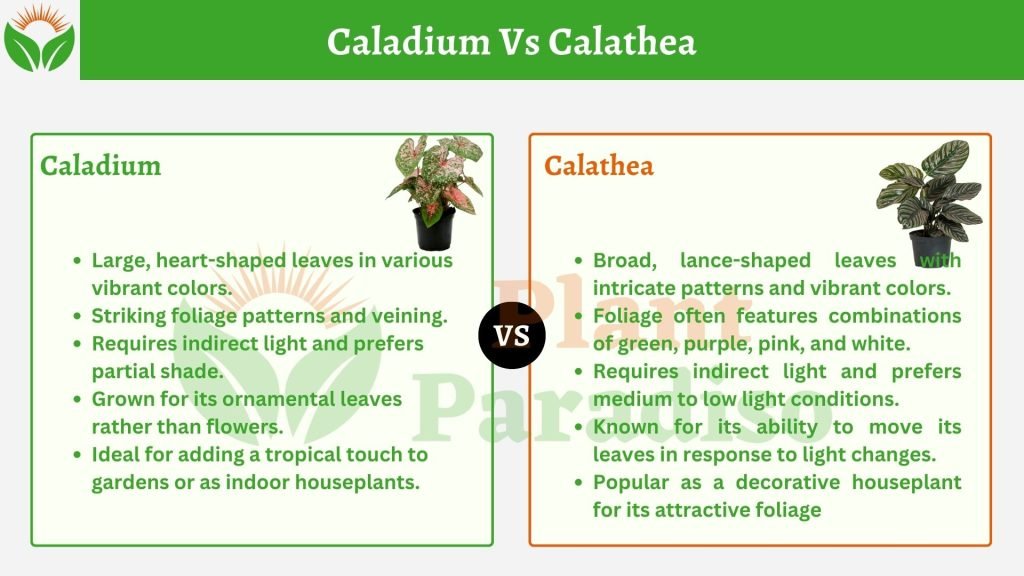
What Makes Caladiums So Special?
Known for their heart-shaped leaves and stunning multicolored hues, Caladiums pack a visual punch in gardens and indoor spaces. Here are some of their stand-out qualities:
- Striking foliage: Caladium leaves can grow up to 12 inches long, featuring prominent centralized veins and a range of color combinations. Solid shades, speckles, veins, stripes, and margined edges create distinct varieties.
- Thrives in shade: With their preference for partial to full shade, Caladiums excel in low-light corner spots where other plants struggle. Their vibrancy brightens up shaded nooks.
- Ideal for containers: Compact tuber growth makes Caladiums perfect for potting in containers and arrangement. Their bushy growth fills pots with vibrant color.
- Low maintenance: Once established, Caladiums are relatively easy care. Just provide evenly moist soil and partial to full shade.
- Goes dormant: After flowering, Caladium tubers go dormant in fall until the following spring. Their annual growth cycle makes rotation easy.
With hundreds of varieties to choose from, it’s easy to find a Caladium to fit your aesthetic. Their dazzling colors and textures bring life to gardens and indoor spaces.
What Makes Calathea Such A Unique Houseplant?
Known as “prayer plants” for the way their leaves fold up at night, Calathea offers some of the most intricate foliage patterns in the plant world. Here’s an overview of what makes them special:
- Artistic leaves: Oval-shaped Calathea leaves feature colorful geometric patterns. Designs like rattlesnake, fishbone, and feathering create living works of art.
- Prefers bright indirect light: While they don’t like direct sun, Calathea thrive in brightly lit indoor spots with filtered sunlight. Their designs stand out best with adequate light.
- Likes warm temperatures: With an ideal temperature range of 65-75°F, Calathea does best in normal indoor room temps. Cool drafty spots can cause leaf damage.
- Appreciates humidity: Mist your Calathea regularly and place on a pebble tray to recreate the humidity of its tropical origins. This keeps leaves lush and vibrant.
- Prayer movement: Calathea leaves open with the morning light and close up vertically at night, resembling prayer hands. This unique movement signifies a thriving plant.
With endless varieties and mesmerizing patterns, it’s easy to get drawn in by Calathea’s exotic tropical allure. Their artistic leaves make a living statement in any indoor space.
Related articles:
How Are Caladium and Calathea Different? Key Distinctions
While both offer fabulous foliage, Caladium and Calathea have some notable differences when it comes to their appearance, growing needs and general characteristics:
1. Lighting Needs
- Caladiums prefer partial shade to full shade. Leaves can burn if given too much direct sun.
- Calatheas need bright, indirect light to thrive. Their designs look best in rooms with ample filtered sunlight.
2. Watering and Humidity
- Caladiums like consistently moist soil during growth periods. Their large leaves lose water quickly in heat.
- Calatheas require very consistently moist soil at all times. They also appreciate higher humidity than Caladiums.
3. Temperature Tolerance
- Caladiums thrive with warm temperatures above 60°F. Anything colder can disturb growth.
- Calatheas prefer steady room temperatures between 65-75°F. Avoid drafty spots.
4. Leaf Size and Growth
- Caladium leaves grow much larger, up to 12 inches long in some varieties. They make big, bold statements.
- Calathea leaves max out around 6 inches but boast more intricate patterns and designs. Their look is more delicate.
5. Maintenance Needs
- Caladiums have medium maintenance needs- regular watering and fertilizing. But less intensive than many houseplants.
- Calatheas need more attentive care, especially when it comes to moisture and preventing crisp leaves. Their requirements are higher.
6. Pet Friendliness
- Caladiums are toxic to pets and should be kept out of reach of curious cats and dogs.
- Calatheas are non-toxic to pets, making them safer for households with furry friends.
By understanding these key differences, you can better gauge which plant aligns with your growing conditions and plant parenting style.
5 Best Caladium Varieties For Indoors
With hundreds of Caladium varieties to pick from, here are some top performers for indoor containers and shady garden spots:
- ‘White Queen’ – A classic white-leafed variety with vibrant green veins and ruffled margins. Pops in shady spots.
- ‘Red Flash’ – Deep red leaves with dark green edges and white veins. Stunning contrast.
- ‘Florida Sweetheart’ – Rosy pink leaves with dark green edges and red veins. Cheerful color.
- ‘Aaron’– Vibrant red leaves punctuated with pink spots and white veins. Very eye-catching.
- ‘Frieda Hemple’ – Fuschia-pink leaves with dark green edges. Looks lovely paired with darker foliage.
For more color variety, look for mixes like Colorburst with a blend of red, pink, white, and green leaves all in one container.
5 Calathea Varieties That Stand Out As Houseplants
Calathea offers endless variety when it comes to leaf patterns and colors. Here are some top picks for eye-catching houseplant displays:
- ‘Rattlesnake’ – Long tapered leaves with snake-like yellow striations on a green background. Very striking.
- ‘Ornata’ – Intricate pink brushstroke patterns across glossy green oval leaves create visual depth.
- ‘Medallion’ – Dark green velvety round leaves with light green brushstroke centers and purple undersides.
- ‘Freddie’ – Foliage starts green and matures to yellow-green with stripe markings. Graceful form.
- ‘Warscewiczii’ – Narrow leaves boast dark green and light green stripes. Grows in a bushy upright clump.
Go bold with patterned varieties or choose more solid color options like the deep green ‘Bicajoux’ – the choices Calathea offers are incredible.
Let’s Try to Find a Suitable Match..
When deciding between these two tropical beauties, consider your space and skill level to choose the best match.
Caladiums work well for:
- Shady indoor spots and gardens with filtered or indirect light.
- Beginner plant parents- they are relatively low maintenance.
- Adding pops of color, textures, and bold foliage impact arrangements and gardens.
Calatheas work well for:
- Bright indoor spaces with ample indirect sunlight.
- Those looking for a pet-friendly houseplant- they are non-toxic to cats and dogs.
- Adding artistic, patterned leaves with delicate tropical accents to plant displays.
- More experienced plant caretakers who can accommodate their higher moisture and care needs.
While their care differs a bit, both offer incredible payoff with their vibrant colors and tropical vibes. Let your space conditions and personal preferences guide you to your perfect fit.
The stunning diversity of Caladiums and Calatheas makes it possible to find a variety tailored exactly for your unique indoor habitat. Choosing between these foliage superstars is a win-win situation!
Conclusion
Choosing between Caladium and Calathea comes down to their different needs. Caladium thrives in shade with warm temps and moist soil. Its huge colorful leaves make bold statements. Calathea does best in indirect sunlight and prefers more consistent moisture. With artistic slender leaves, it brings delicate jungle vibes.
Consider your space and care capability to pick the variety that fits best. Both offer stunning tropical accents for your indoor garden. Pick the one suited for your home conditions and enjoy their vibrant beauty!

